The Ancient City of Plovdiv
The central Bulgaria travel route includes the ancient city of Plovdiv, the historic capital of Veliko Tarnovo, and the romantic Rose Valley, combining cultural heritage with pastoral scenery. If you were to pick one city in Bulgaria most worth visiting, it would undoubtedly be Plovdiv. It is not only the cultural emblem of Bulgaria but also one of the oldest cities in Europe, with a history spanning over six millennia.
Plovdiv lies on the ancient land of Thrace, with evidence of human habitation dating back to 6,000 BCE. By around 1,000 BCE, the settlement had grown into one of the most important towns in the Thrace region. In the 6th century BCE, it came under the rule of Darius I of Persia, becoming a Persian tributary. In the 4th century BCE, Philip II of Macedon, father of Alexander the Great, incorporated the city into his empire and named it Philippopolis. The city changed hands multiple times between the Macedonians and Thracians until it was absorbed into the Roman Empire, becoming the provincial capital of Thrace under the name Trimontium.
Plovdiv flourished during Roman rule. The remains of temples, baths, theaters, stadiums, and a well-preserved ancient water supply system reveal a vibrant and prosperous city during this period. From the 6th century onward, the city’s history became intertwined with that of Bulgaria. With the arrival of the Bulgars and Slavs, Plovdiv became an integral part of Bulgarian territory. Over the next centuries, the Bulgarians successfully recaptured the city from the Byzantine Empire twice. However, in the 14th century, the city fell to the Ottoman Empire, which ruled it for 500 years until Bulgaria gained independence in the 19th century.
Today, Plovdiv is Bulgaria’s second-largest city and one of its most popular tourist destinations. The city is divided into eastern and western districts. The western side is the modern area with newly built residential neighborhoods, while the eastern side preserves the old town. The historic district features the ancient Roman city of Trimontium, the Roman stadium, the Dzhumaya Mosque, Roman castle ruins, and architectural gems from the Bulgarian National Revival period. A visit to Plovdiv would not be complete without exploring this renowned historical preservation zone.
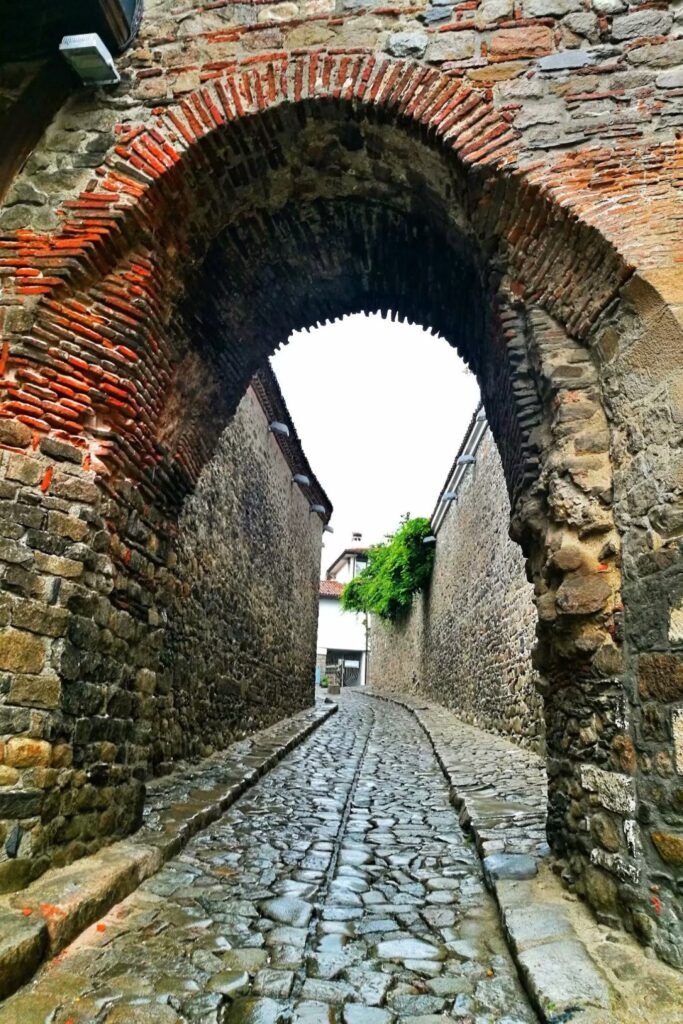
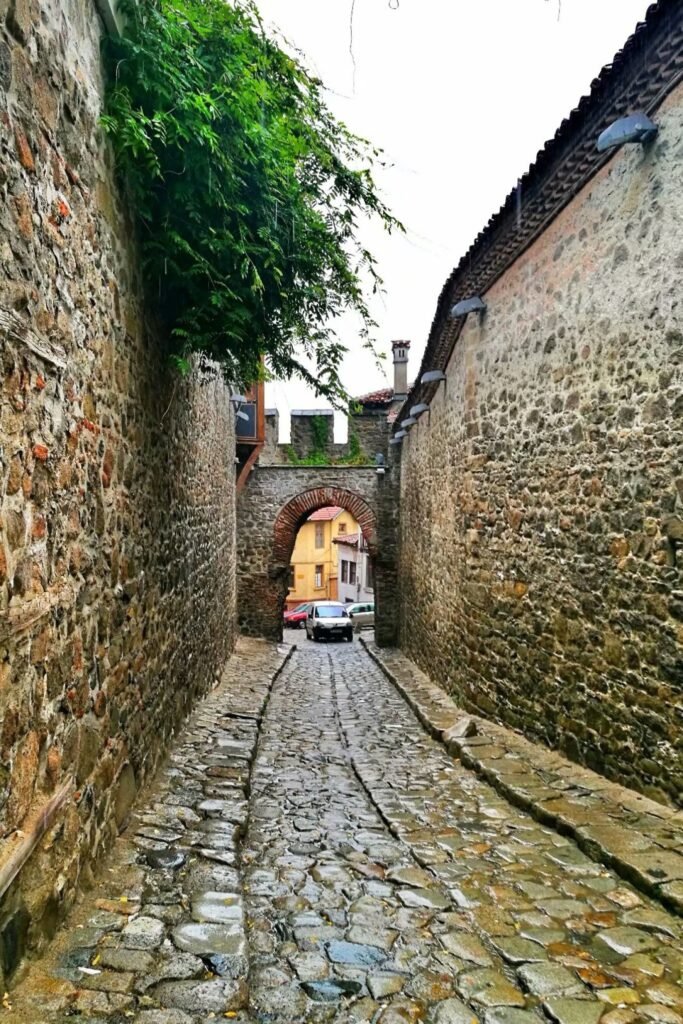
Hisar Kapiya (East Gate)
The East Gate of Plovdiv’s old town is the main entrance to the ancient city and one of the few well-preserved historic structures with significant cultural value. During the Roman era, this gate also served as an important route leading to the Far East.

Plovdiv Museum of Natural History
Ticket: 4 BGN for adults
The Plovdiv Museum of Natural History mainly focuses on the history of the Renaissance period. However, its exhibits are quite diverse, covering Plovdiv’s natural environment, flora and fauna, as well as housing a planetarium and an aquarium. It offers a bit of everything, though none in great depth, making it a site that visitors may or may not choose to include in their itinerary.

Nedkovich House
Ticket: 3 BGN for adults
The Nedkovich House belonged to Nikola Nedkovich, a renowned local merchant and social activist. Built in 1863, the house features a grand facade with three large arched doorways, exuding elegance and charm. Inside, the combination of geometric patterns and colorful paintings creates a vibrant atmosphere. It stands as a classic example of European-style architecture from the period.
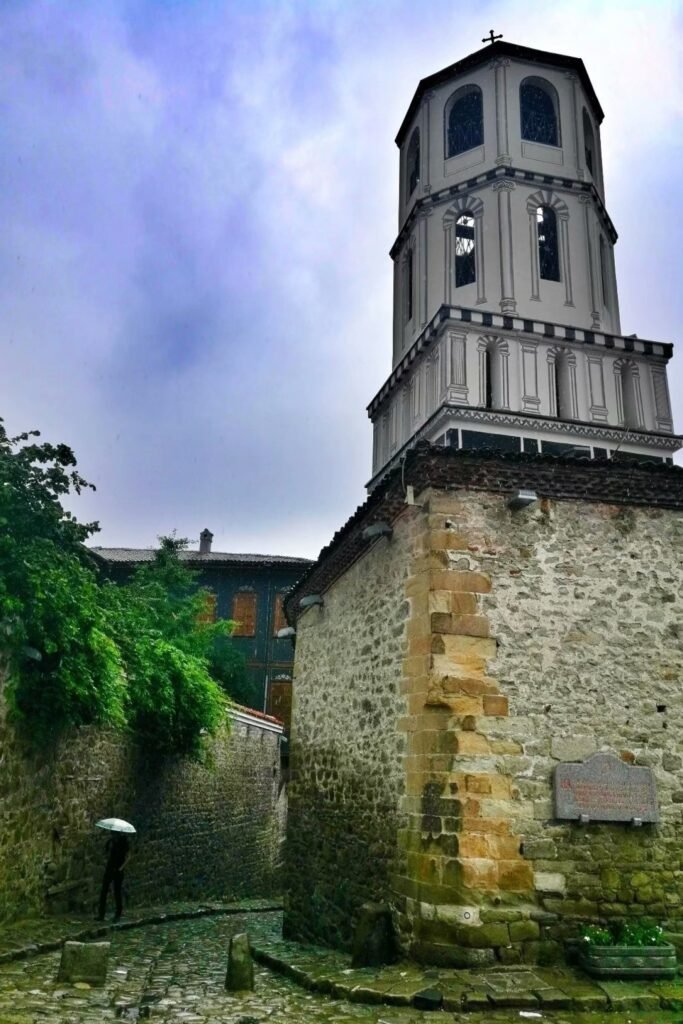
Church of St. Constantine and St. Helena
The Church of St. Constantine and St. Helena was built to honor Emperor Constantine the Great and his mother, Helena. It is one of the oldest churches in Plovdiv. Situated near the eastern gate of the old town, the church stands on an elevated slope, making its white bell tower, enclosed by dark grey walls, a striking sight from afar. This landmark is a significant representation of the city’s religious and historical heritage. Inside, the church features simple and modest decorations, creating an atmosphere of solemnity and dignity that contrasts with the opulence of more luxurious interiors.
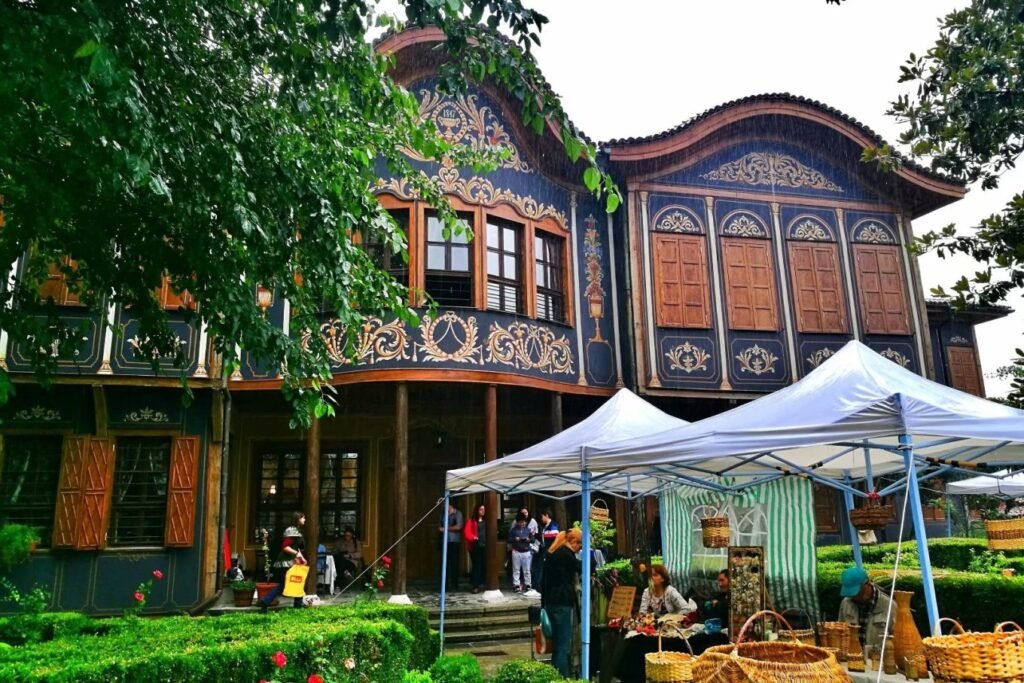
Regional Ethnographic Museum of Plovdiv
The Regional Ethnographic Museum of Plovdiv is the second largest ethnographic museum in Bulgaria and a prominent attraction in the old town. It is an embedded structure within the city walls, featuring the National Revival architectural style from the period of the Second Bulgarian Kingdom. The main building contains 22 rooms divided into various exhibition halls, providing a comprehensive display of the local culture, traditions, and folk customs.


Hindliyan House Museum
Ticket: 5 BGN for adults
The Hindliyan House Museum is one of the most representative private mansions in Plovdiv. Its owner, Stepan Hindliyan, was a wealthy Armenian merchant. The interior and exterior walls are adorned with paintings depicting various cities, including Constantinople, Venice, Saint Petersburg, and Stockholm, along with geometric decorative patterns. The living room features a built-in fountain, adding to the house’s charm. The exterior is painted in a dreamy sky-blue color, giving the building the appearance of a ceramic artwork.
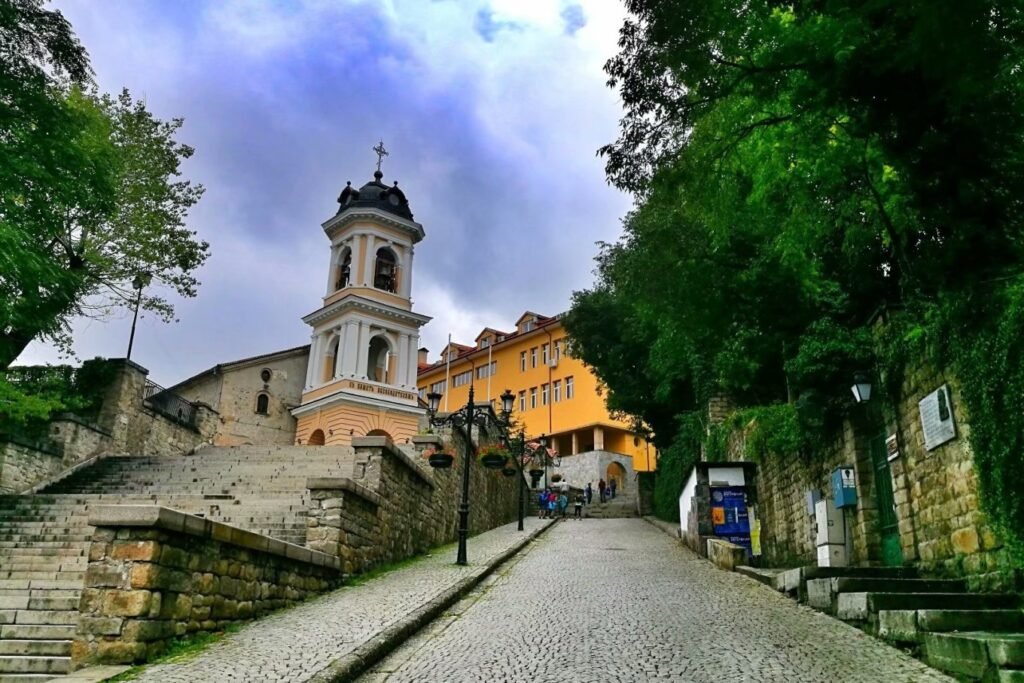
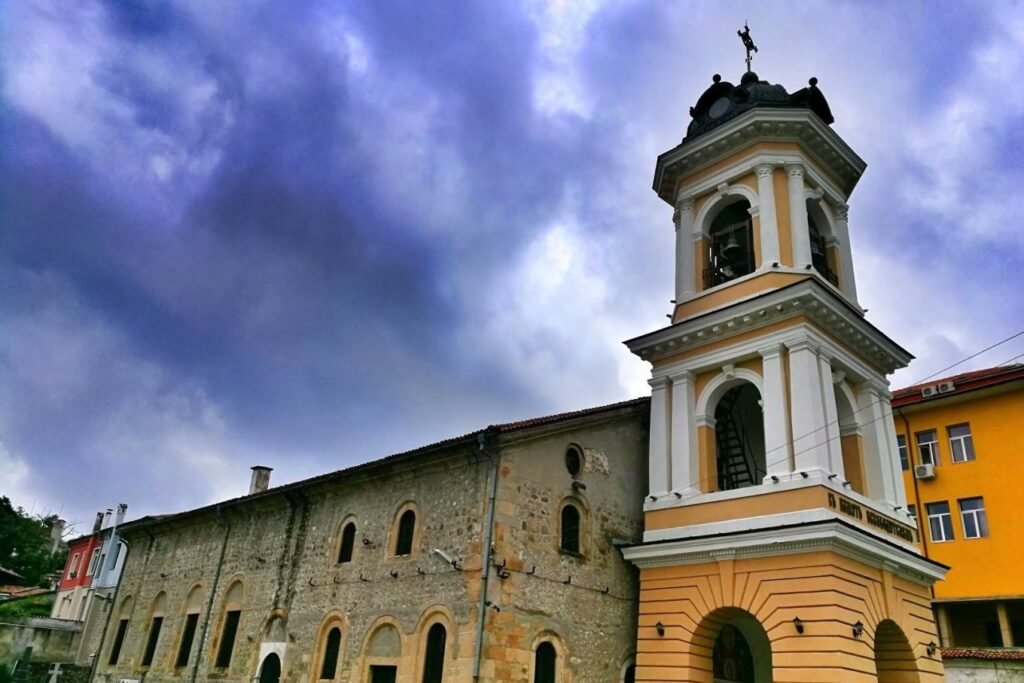
Dormition of the Holy Mother of God Cathedral
The Orthodox Diocese Cathedral of Plovdiv is built on a small hill, giving it a majestic appearance, especially when illuminated at night. It was dedicated to the Dormition of the Virgin Mary and was initially constructed during the medieval period. The church has been destroyed and rebuilt multiple times. The current structure reflects restorations from different eras. Its high stone steps and stone courtyard leave a lasting impression, and the frescoes inside the church are also noteworthy.
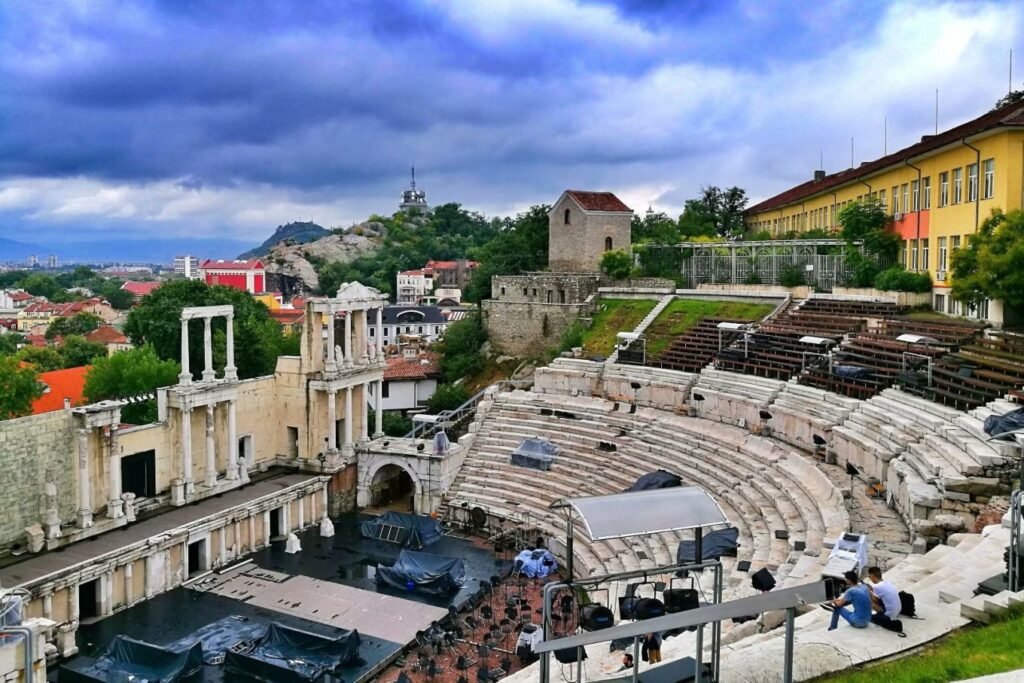
Ancient Roman Amphitheater
Built in the 2nd century, the ancient Roman amphitheater is one of Bulgaria’s most renowned Roman-era heritage sites and one of the best-preserved Roman theaters in the world. The entire theater was constructed along the slope of a hill, with 20 rows of seats descending in a semicircle around the stage. The stage itself consists of three levels, each adorned with exquisite statues showcasing masterful craftsmanship. The amphitheater was meticulously built using pure white marble and has a capacity of 7,000 people. It is said that it took a full decade to clear 15 meters of soil covering the ruins, allowing the theater to emerge into the light once again. Today, it remains a prime venue for hosting music performances, operas, concerts, and other cultural events.
The UFO of Buzludzha Mountain
Buzludzha means “glacier,” hence Buzludzha Mountain is also known as Glacier Mountain. Standing at 1,441 meters, it is located between Kazanlak and Veliko Tarnovo. This mountain was the main battleground of the 1868 Battle of Shipka, a decisive conflict in which the Bulgarian army, with the help of Russian forces, defeated the Ottoman Empire, driving the Turks out of Pleven.
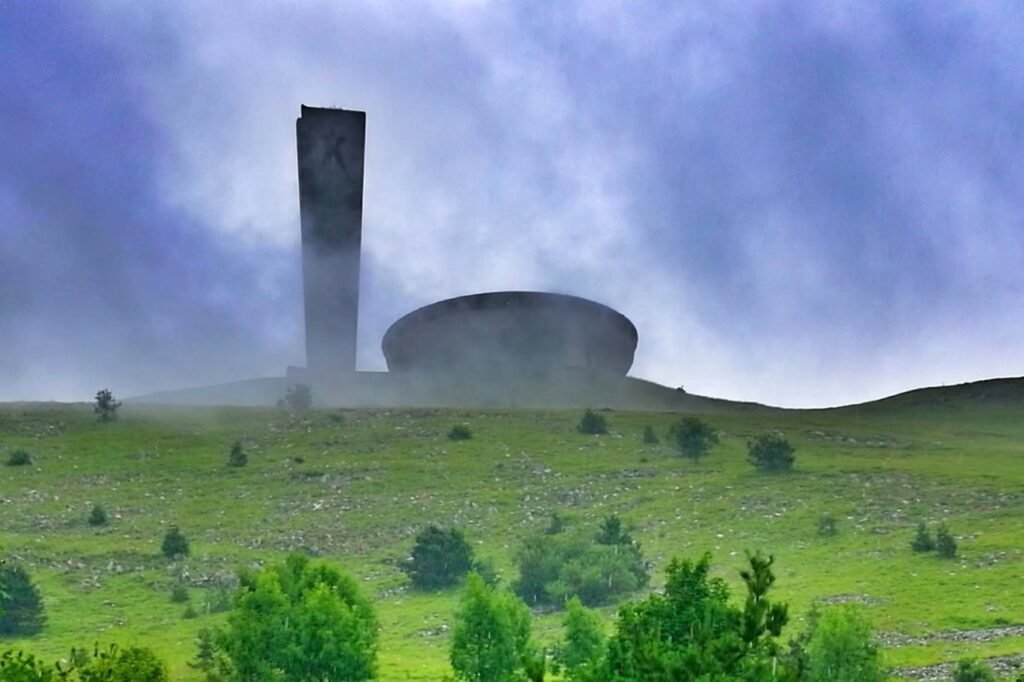

However, Buzludzha Mountain is now famous for a completely different reason: the towering Buzludzha Monument at its summit. This monument, commemorating Bulgaria’s revolutionary history, was erected here because it was where the Bulgarian Communist Party, formerly the Social Democratic Party, once organized revolutionary activities and underground resistance. Building such a massive monument atop this remote, rugged mountain, however, did not take transportation challenges into account. Nowadays, there is no public transportation to the monument—not even to the base of the mountain. Without a car, it’s nearly impossible to reach. Thankfully, we were driving, though even with a car, it took us quite an effort to reach the top through winding mountain roads.
From the base of the mountain, the Buzludzha Monument looks particularly imposing. Although called a monument, it is more accurately a complex of buildings. Upon reaching the summit, we saw that the structure consists of a tower and a circular building. The tower, standing about 70 meters tall, is adorned with two red stars. The circular structure resembles a sports arena, and from the outside, it looks much like an alien spaceship, which is why people now commonly refer to it as the “Buzludzha UFO.”
Today, the UFO is almost entirely abandoned. Built in 1981, the monument was deserted after Bulgaria’s socialist regime collapsed in 1989. For two decades, it was forgotten, but at some point, it unexpectedly gained renewed attention. Whether due to nostalgia or curiosity, more and more people have made the trek to see it, despite the long journey and difficult access. Ironically, the structure has become even more famous in its abandoned state than it ever was during its prime—a development that probably would have surprised its original builders.
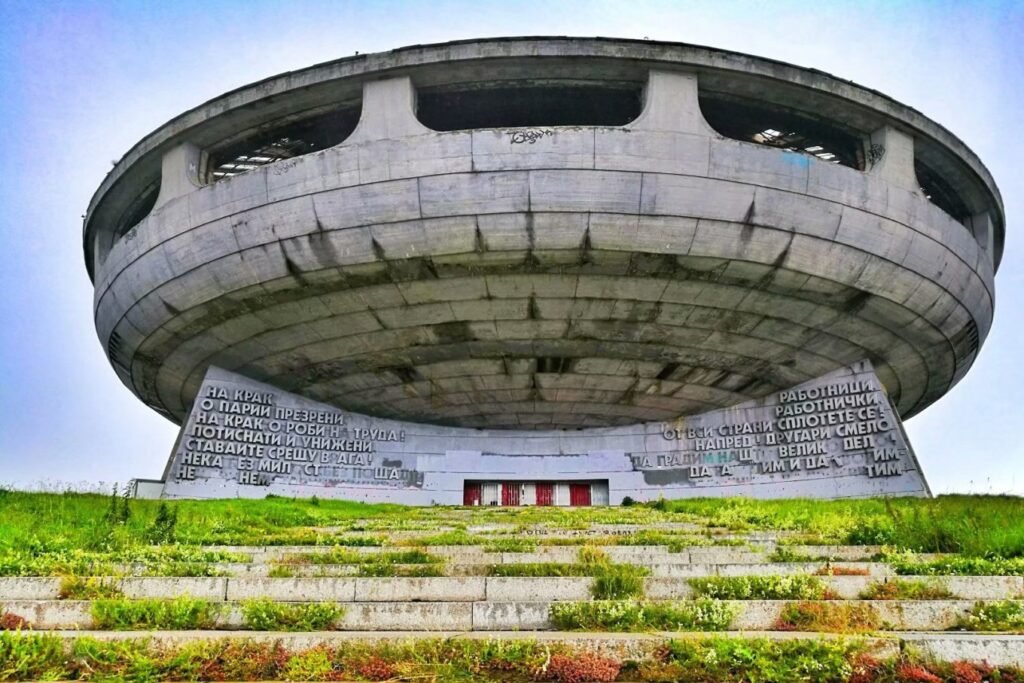
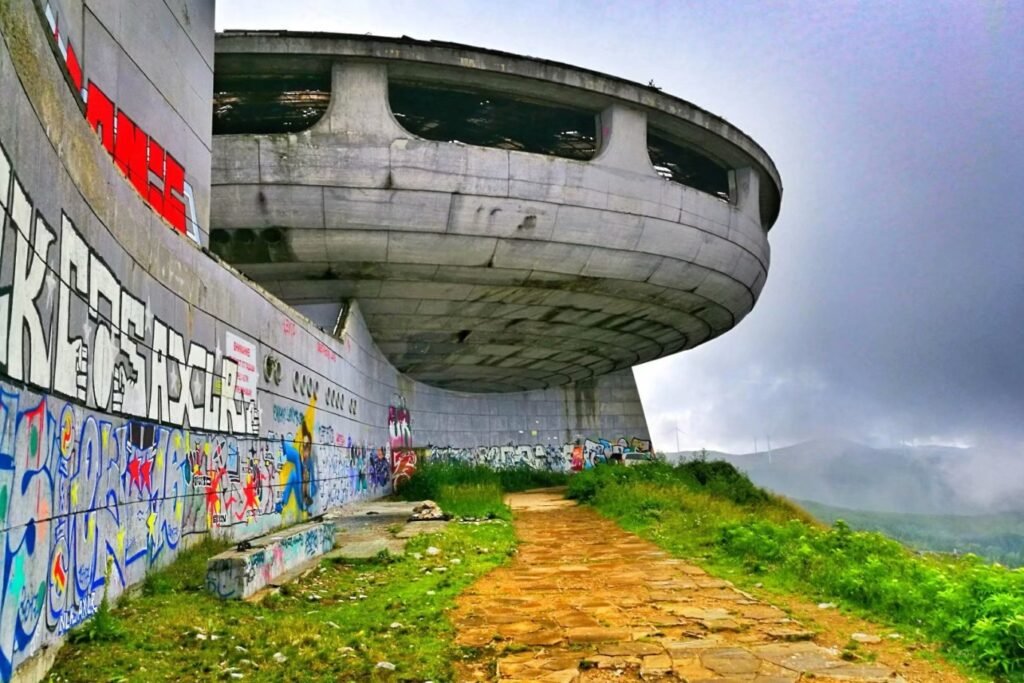
As we approached the massive structure, we saw that its exterior walls were covered with colorful graffiti, transforming it into a canvas for rebellious expression. Interestingly, the quality of the construction remains impressive, a testament to the focus on political projects at the time. The steel and concrete used are still intact, and the building’s exterior stands tall. However, the interior is heavily damaged, with the roof particularly deteriorated. The main entrance is now sealed off, officially closing it to the public. Visitors can only explore the exterior and peek inside through cracks in the walls. Through gaps in the damaged roof, faint light filters into the hollow, eerie hall within, revealing little beyond emptiness. Some fragments of mosaic murals remain on the walls, depicting scenes from Bulgaria’s communist revolution and socialist construction efforts.
The monument now stands as a relic of history, its once-significant political meaning eroded with time. Given its vast size and limited purpose, it seems unlikely that anyone will fund its restoration. Its fate is to remain abandoned, slowly succumbing to the passage of time, and eventually fading into oblivion.
The Former Capital Veliko Tarnovo
Veliko Tarnovo, located in the heart of central Bulgaria, is a city nestled between mountains and rivers. The ever-flowing Yantra River runs in front of the city, while the scenic Tsarevets Hill rises behind it. The city is built on these natural formations, with its densely packed houses arranged along the slopes and valleys in a way that appears both orderly and organic. Its layout is natural yet grand, with buildings rising and falling with the landscape.
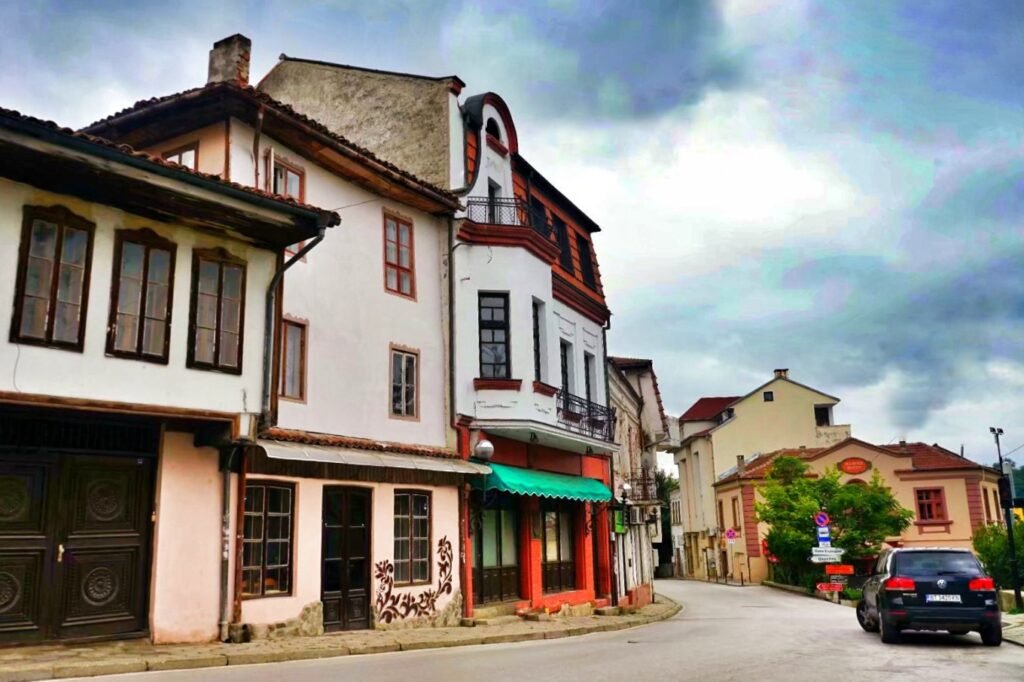
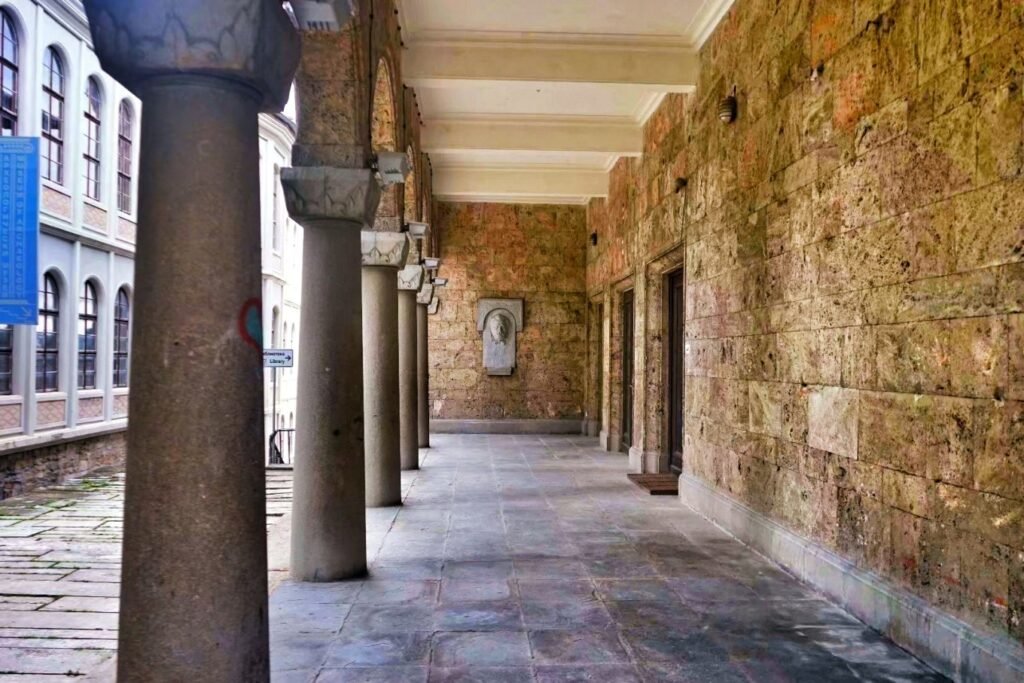
Veliko Tarnovo is an ancient city with a history spanning thousands of years. During the Byzantine era, it was the second-largest city on the Balkan Peninsula, after Constantinople. Historically, it also served as the capital of the Second Bulgarian Empire. Today, remnants of its glorious past can still be found throughout the city, including ancient walls, fortresses, palaces, monasteries, and precious manuscripts and artwork left by past rulers. Among these, the most iconic is Tsarevets Fortress.
The modern city of Veliko Tarnovo is divided into two main parts: the eastern part, which is the old town, and the western part, which is the newer section. The old town contains most of the city’s historical and cultural landmarks, making it the focal point for visitors interested in history and heritage. The western area, developed during the Bulgarian Communist era, features mostly socialist-style architecture, along with some modern buildings constructed in recent years.


The Monument of the Asen Dynasty
The Asen Dynasty refers to the Second Bulgarian Empire, established by brothers Ivan Asen I and Peter IV, which lasted from 1185 to 1388. This monument was erected in their honor. It consists of statues of four horsemen and a sword thrust skyward, symbolizing their power. The monument is situated in Alexander Park, located on the Sacred Mountain Island, encircled by the flowing Yantra River, offering breathtaking views of the surrounding landscape.

Boris Denev National Art Gallery
Located next to the Monument of the Asen Dynasty, the Boris Denev National Art Gallery is one of Bulgaria’s oldest and most distinctive galleries. It houses a vast collection of artworks created by Bulgarian artists, along with a variety of other art pieces. The gallery offers free admission every Thursday.

Ascension Cathedral
Entrance Fee: 5 Euros
Ascension Cathedral stands at the heart of Tsarevets Fortress, not only marking the highest point of the fortress but also the highest point in the entire city. The cathedral, with its commanding presence, boasts two distinctive features. First, although it follows the traditional design of three naves, it is equipped with a towering bell tower—a rare element in Balkan-style church architecture. Second, the interior is surprisingly adorned with decorations from Bulgaria’s socialist era. However, the murals within the church are relatively recent, with the earliest dating back only to the 1930s. The artistic styles range from classical Byzantine paintings to surrealist works.
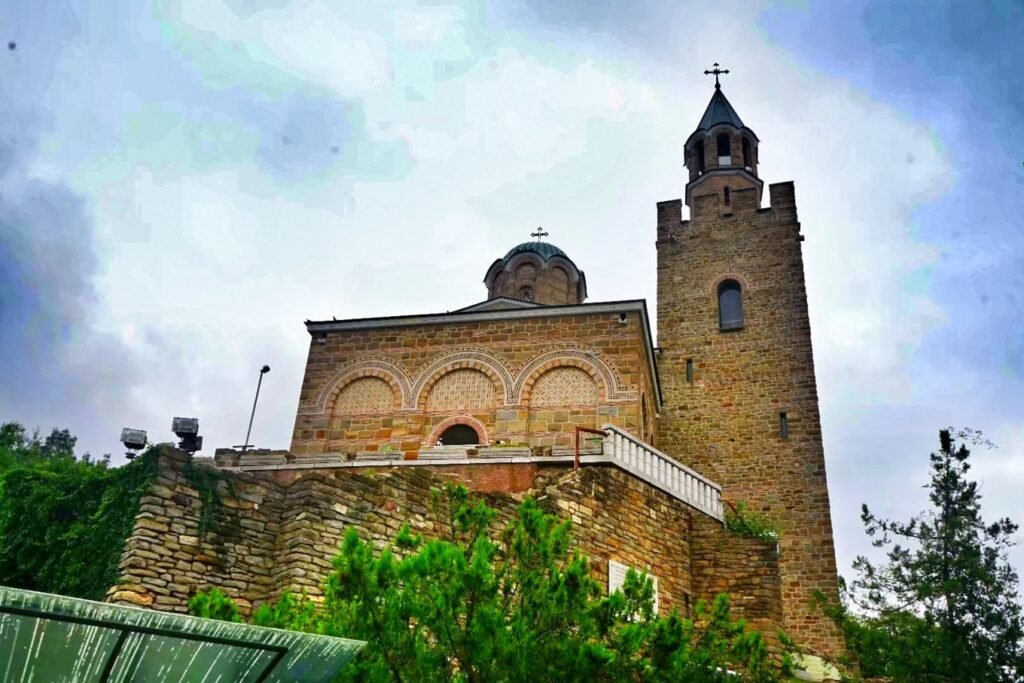
“Tsar Asen I” Square
On the way to the fortress, you will inevitably pass through Tsar Asen I Square. This square serves as the connecting point between the old town and the fortress. It is surrounded by restaurants, bars, hotels, and bus stations, making it a hub for accessing the fortress and enjoying panoramic views of the city.

Tsarevets Fortress
Ticket price: 6 lev for adults
Tsarevets Fortress, also known as the Palace of Bulgarian Kings, is the most famous tourist attraction in Veliko Tarnovo. It is located atop Tsarevets Hill in the eastern part of the city, offering panoramic views with the beautiful Yantra River flowing around the base of the hill.
The main structures of the fortress consist of two parts: the palace complex and the patriarchal complex. The western side holds the fortress’s main entrance, guarded by four gates and several towers. In front of the first gate, a moat and drawbridge enhance the impression of the fortress’s impenetrable defenses. The most remarkable parts of the fortress are the Throne Hall and the Church of Saint Petka in the palace complex.
During the Second Bulgarian Empire, this fortress was the site of the royal palace. Unfortunately, most of the palace was destroyed during the Ottoman Empire’s rule.


